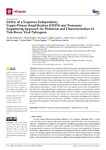Utility of a Sequence-Independent, Single-Primer-Amplification (SISPA) and Nanopore Sequencing Approach for Detection and Characterization of Tick-Borne Viral Pathogens
Brinkmann, Annik
Uddin, Steven
Krause, Eva
Surtees, Rebecca
Dinçer, Ender
Kar, Sırrı
Hacıoğlu, Sabri
Özkul, Aykut
Ergünay, Koray
Nitsche, Andreas
Currently, next generation sequencing (NGS) is the mainly used approach for identification and monitorization of viruses with a potential public health threat in clinical and environmental samples. To facilitate detection in NGS, the sequence-independent, single-primer-amplification (SISPA) is an effective tool for enriching virus sequences. We performed a preliminary assessment of SISPA-nanopore sequencing as a potential approach for screening tick-borne viruses in six specimens with detectable Crimean-Congo hemorrhagic fever virus (CCHFV) and Jingmen tick virus (JMTV) sequences. A comparison of unbiased NGS and SISPA followed by nanopore sequencing was carried out in 4 specimens with single and pooled ticks. The approach was further used for genome sequencing in culture-grown viruses. Overall, total/virus-specific read counts were significantly elevated in cell culture supernatants in comparison to single or pooled ticks. Virus genomes could be successfully characterized by SISPA with identities over 99%. Genome coverage varied according to the segment and total read count. Base calling errors were mainly observed in tick specimens and more frequent in lower viral loads. Culture-grown viruses were phylogenetically-related to previously-reported local viruses. In conclusion, the SISPA + nanopore sequencing was successful in generating data comparable to NGS and will provide an effective tool for broad-range virus detection in ticks.
Dateien zu dieser Publikation

